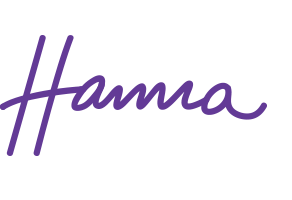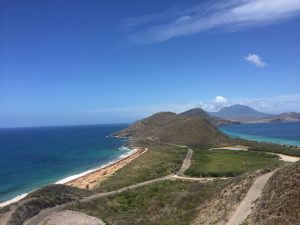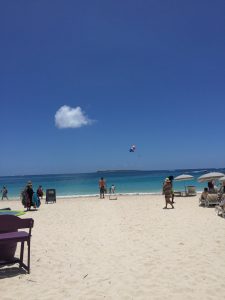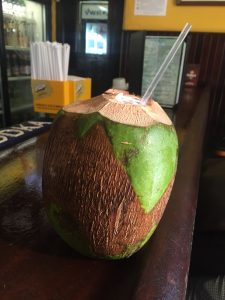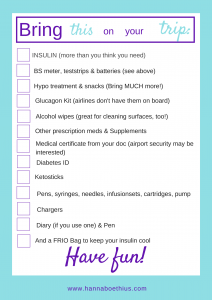Type 1 Thursday – Jet Lag and Blood Sugar Impact?
How does jet lag affect blood sugar? And how can you ease the burden?
Last week, I attended the most incredible of events, KetoCon 2019, in Austin, TX (awesome city, btw! If you haven’t been yet, you gotta go!). With closer to 3 000 people attending the event, it was amazing to talk to people, connect, share stories and experiences, meet new friends, listen to mind blowing talks with tons of new knowledge. I also had the incredible honor of being a speaker at #ketocon2019, which was an unforgettable experience! (Universe, please send me more speaking gigs! Kthx!) It really is an amazing community, and I’m so proud and honored to be a part of it.
With traveling that far, however, comes a certain amount of jet lag. 7 time zones back and forth within a week is a little…. intense. So I wanted to tell you about how jet lag impacts blood sugar, and share some of my tips on how to make the jet lag easier on you.
What are your best jet lag tips? Let me know in a comment!
Transcription
If you prefer to read, here is the typed up version of the video above:
Today’s topic has been a part of my life for the past week or so. So I thought if it affects me, then it may affect someone else out there.
I recently attended KetoCon 2019, in Austin, Texas, where I was also fortunate enough to be a speaker. I was very, very touched and humbled by that. I had a fantastic time! The amount of people that I met, the awesome storys that I heard, connections, some of the samples I tried… Everything was amazing! So many people were there, it was a huge event this year, closer to 3000 people. I was very, very fortunate to be there! I really hope that I get to go back to KetoCon next year, and I hope that you will join me there as well.
I love travelling! Sometimes with the travel comes changing time zones, perhaps not all the time. But when it does, meaning that your body might be stuck in one time zone, where as you have moved on to the next. That discrepancy between what your body feels like and what it actually what time it actually is, where you are is called a jet lag. This time, we did a very short trip to the States, it was only a week back and forth. It was a little bit intense. Usually, there is a way or direction that it’s easier for us. For me, it’s going to the east, which is apparently uncommon, I have a lot easier to come home from the States to Europe, then going to the States. This will be taken into account for future trips, believe me…
Jet lag can also affect your blood sugar because your body feels like it is in a different time zone than you are and your insulin pump settings are not in tune with your body’s needs. This is despite that you have changed your insulin pump settings by the time you touch down on the new ground. Your body might need a different amount of insulin than what you are giving in at that point in time. This also happens with basal insulin, or long acting insulin, it’s not novelty for insulin pumps.
It is also a huge stress for the body to change time zones. It gets all confused about times and when to sleep and when to stay awake and when you’re hungry and when you need to drink. And when you have insulin, for example. We also know that stress is a blood sugar killer. Because this is such a stress for the body, this can really cause havoc on your blood sugars. (It wasn’t too bad for me personally, this time. I suffered more from a terrible pump site, than the jet lag itself.) And it didn’t help that I was travelling very quickly back and forth, across 7 timezones within a week.
I was going to share a couple of my best jet lag tips. Although they’re not 100%, clearly, but they may alleviate a little bit so that you don’t have to have such a bad time as you may think it might. So first of all, I wanted to clarify that actually a lot of jet lag is a mindset. If you decide that it’s going to be a terrible time being jet lagged. Guess what? It’s going to be a terrible time to be jet lagged for you! That’s not really any magic. If you decide that hey, yes, okay, admit to yourself, yes, it’s not going to be great. But at the same time, it’s going to be worth it for what I’m doing. You’re already halfway there. If you then also add to it that I’m really excited to go and I can’t wait to see what awaits me where I’m going.
Change the timezone already before you leave. That way you are a little bit more acclimatised to the new time zone even before you leave home. That can involve blocking sunlight, when it’s supposed to be night in the new time zone, or it can be being in front of really bright lights when it’s going to be sunshine and it wasn’t at home. Or it can be regulating caffeine intake, all kinds of things. And there’s a lot you can do yourself. But of course, there’s also apps and I just did a quick search on App Store, and there are so many jetlag apps that you can use. Go explore and find what works for you.
Also, hydration is super, super important for trying to prevent as much as possible of jet lag. First and foremost, this is very important while you’re up in the air, because being that high up anyways dehydrates your body. Don’t make it worse for yourself, as dehydration can cause even more problems. A little bit of electrolytes might not be the worst thing to keep your body fully hydrated, healthy and happy throughout your journey.
Make sure that you expose yourself to sunlight when you’re supposed to. When you have arrived go outside, hopefully it is during daylight time, so that you and your brain and your eyes and all this stuff that works together gets used to when it’s supposed to be dark, when it’s supposed to be light. Sunlight is healing, as we all know, lots of vitamin D, that’s great. Also the fresh air helps to maybe keep you awake rather than stuffy indoor air, when you’re not supposed to sleep.
Stay awake until at least 10pm local time, or whatever your bedtime is, so that you are least a little bit more on to the new time zone. There’s also of course includes no napping, do try to stay awake as much as you can until as late as you can or until your bedtime, whatever hits first. And then hope for a really, really good night’s sleep. If you can’t sleep through the night, which may have been my problem going to the US, definitely do a lot of meditation, a lot of snoozing until you feel ready to fall asleep again. You can also add supplements, such as melatonin and that can really help at least to go to sleep. It’s still debated on whether it helps you to stay asleep but it may help to go to sleep. You can also try things like over the counter histamine drops. Check with your doctor first. CBD oil can also help you sleep when you’re supposed to sleep, as does double magnesium.
Being in nature in the time zone that you’re not used to yet and enjoy the walk. That also keeps you from sleeping when you shouldn’t sleep. Do some yoga doors perhaps, there’s also a lot of jet lag yoga on YouTube, for example, that was very helpful for me, as well. But forest bathing definitely does help.
Keep busy. When I got home yesterday morning, I made sure to unpack my whole bag, put on the washing, so that I had something to do the whole time so that I wouldn’t fall asleep. Today, I feel a lot better, probably also thanks to my hydration plan and my forest bathing and meditation and all these things that I do implement for in order to help my jet lag along a little bit quicker and not just suffer from it.
What are your best jetlag tips I can’t wait to talk with you more in the comments below.
And wherever you are exploring next, enjoy and hope the jet lag is not too bad.
